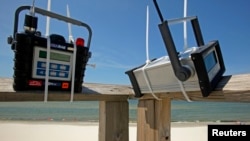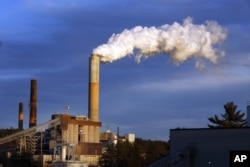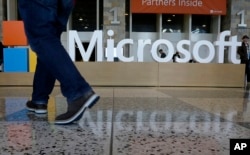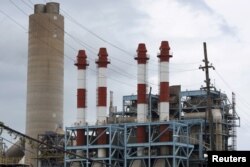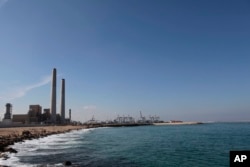Europe does it. Japan does it. Some corporations do it. Even China says it’s going to do it.
And with negotiators gathering in Paris for major U.N. climate talks, calls are intensifying to make all polluters pay a price for carbon dioxide and other planet-warming emissions.
Many economists back the approach as a market-friendly way to cut global warming pollution.
The U.S. Congress is hostile to the idea. But it’s gaining traction anyway, in U.S. statehouses and corporate boardrooms.
Self-imposed carbon taxes
Some businesses already have self-imposed carbon taxes. And some states are taking a look at the one program in the United States that’s been making power plants pay for their emissions since 2008.
A tech-sector giant is on board.
Worldwide, the power-hungry information and communications technology industry is responsible for about two percent of global greenhouse gas emissions, about the same as the airline industry. And power demand keeps growing as phones, tablets and other devices proliferate.
In 2012, software giant Microsoft was planning a big expansion of its cloud-computing services. Packaged software was on the decline. Customers were increasingly doing their computing on remote servers.
But running more servers was going to take a lot more electricity. And like other tech giants, Microsoft pledged to be carbon-neutral.
The challenge was getting business managers on board with reducing their impact.
Sustainability chief T.J. DiCaprio said that meant speaking their language.
Tech taxes itself
A metric ton of carbon dioxide is “a nebulous concept to the business people,” she said. “It was much more direct to speak in terms of a dollar per metric ton and a charge on their profit and loss statement.”
So the company began tallying the amount of electricity their data centers consumed, calculating how much CO2 was produced generating that electricity and charging managers a fee per ton.
With a carbon tax on their balance sheets, DiCaprio said, managers found ways to cut energy use, like reducing server idling time and cooling data centers with more fresh air.
“That’s the beauty of this model with the price signal,” DiCaprio said. “It helps the managers understand that driving efficiency is critical.”
Efficiency improvements were paid for with funds from the carbon tax. Company-wide, Microsoft says it cut its carbon footprint by 7.5 million metric tons since 2013 and saved more than $10 million per year in energy costs.
The company’s carbon tax also funded carbon-offset programs in developing countries, including tree planting and purchasing more efficient cookstoves that reduce firewood demand.
And DiCaprio said almost no one seems to mind paying the tax.
“I’m pleasantly surprised that the response from the managers has been so positive.” Employees are excited that the company shows environmental responsibility, she added.
Writing on the wall
Microsoft is among the more than 1,000 corporations worldwide that assess themselves a fee for their greenhouse gas emissions, or plan to in the next two years, according to a recent report.
Several energy companies are on that list. Although they don’t pay for their carbon emissions in the United States, they do in Europe, Japan, and a few other countries. Others, including China, have plans to do so.
And companies expect more will require it in the future, according to Eliot Metzger with the environmental think tank the World Resources Institute.
“I think they’ve seen the writing on the wall and they recognize that this is a huge issue that’s going to affect their future markets. And they have to find a way to prepare for that,” Metzger said
Internal carbon taxes can help them identify the most cost-effective ways to reduce their greenhouse gases, he said, before governments do it for them.
Corporations are among the loudest voices calling for commitments to a price on carbon as an outcome of the U.N. climate negotiations in Paris. It’s one of the policies supported by the We Mean Business coalition, which includes 422 companies and investors with more than $25 trillion in assets and revenue.
And six major global oil and gas companies asked for carbon pricing in a letter to the heads of the U.N. negotiations.
New rules
Regardless of what happens in Paris, the U.S. Congress is unlikely to take up the issue. A bid to introduce a carbon market failed in 2010. Opponents said the costs would cripple the economy.
“If there were reductions in carbon dioxide emissions deep enough to perceptibly change climate outcomes, that would require such a horrendous economic sacrifice that the cure would be much worse than the possible disease,” said Marlo Lewis with the Competitive Enterprise Institute, a conservative public policy center.
Congress is currently controlled by lawmakers skeptical about humans’ role in climate change.
But new Obama administration rules have put carbon markets back on the table anyway. The Environmental Protection Agency has issued new regulations that limit emissions, but allow states to come up with their own ways to do it.
Many are looking at the experience of the Regional Greenhouse Gas Initiative (RGGI), a cap-and-trade system covering electric power generators in nine East Coast states.
In cap-and-trade, authorities determine how much CO2 they will allow (the “cap”) and power plants buy a permit for each ton of CO2 they produce. Plant owners can sell permits they don’t use (the “trade”), which gives them a financial incentive to cut their emissions.
The cap is lowered over time, so everyone eventually has to pollute less. But those who do it faster reap the benefits.
Utility company Exelon operates fossil, nuclear and renewable power generation in 19 states including RGGI jurisdictions. Regulatory affairs chief Kathleen Barron said the company supports RGGI.
“It doesn’t pick technologies,” she said. “It picks a carbon outcome and then lets the market decide what’s the cheapest way to get there.”
RGGI sold its first permits in 2008. Since the program began, CO2 emissions have declined 40 percent.
And the economy continued to grow, by eight percent in the RGGI states.
“Opponents of climate action simply say over and over again that you cannot have economic growth at the same time as you’re having strong environmental policy. And evidence demonstrates that that’s simply not true,” said Derek Walker at the Environmental Defense Fund, a green group.
Cheap natural gas, not RGGI, has a lot to do with the decline in CO2. Plus, energy use took a nosedive in 2008 and 2009 during the financial crisis.
And observers say RGGI gave out too many CO2 permits to start with, and prices are too low to provide much of an incentive for companies to lower emissions. But one recent study said emissions would have been 24 percent higher without RGGI. And supporters note that the cap on CO2 permits has been lowered, locking in those reductions.
California launched its own cap-and-trade program in 2012. Others are considering it as a way to comply with the new Obama administration rules.
“States that don’t want to be given a top-down edict by Washington are starting to see that, hey, we might have a tool here that could work,” Walker said.




